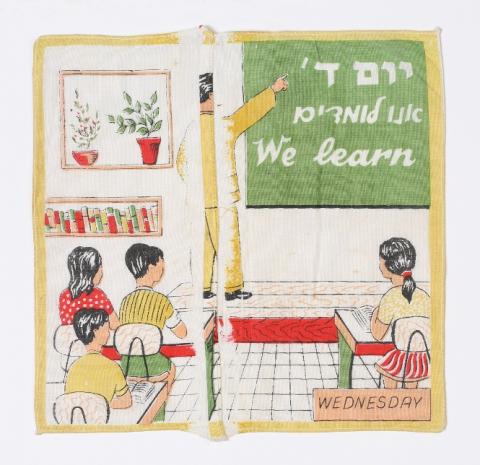The White Cloth Napkin
Those were different times; people carried stiffly-ironed handkerchiefs in their pockets, and the local industry was active and vibrant, decades before competition from India and China killed the Israeli textile industry. Those were the days when cloth napkins, tablecloths and handkerchiefs, were made in Israel, by Israelis, for Israelis, representing the fantasy in which the Mother was in charge of the kitchen, the Father took the Children on a bicycle trip, and the IDF was victorious over all the Arab armies.
The tablecloths, cloth napkins, and handkerchiefs displayed in the exhibition - which is presented during the 2016 Illustration Week, in collaboration with the Tel Aviv Municipality Arts Department - were produced by Had-Ar. Had-Ar was a small family business set up in the early 1940s by Stenia Veroslavsky, an extraordinary woman for her times; she emigrated from Poland at a young age, seeking new business ventures in Palestine. Moshe, her husband, managed the technical aspects of production, and the children took part in cutting, stamping and packing the items on the kitchen's table.
Over time the business grew, moved out of the house, and was set up in Ramat Gan and Tel Aviv-Yaffo. The production methods developed, and shifted to screen printing. The factory commissioned the illustrations that decorated the tablecloths and napkins from artists, some of whom were relatives, among them, Varoslavksy's son-in-law, the graphic artist, Jack Jaget. Had-Ar's items were sold over decades throughout the country, and till today can be found in numerous homes. The factory closed down in 2007; Stenia Veroslavsky died in 2013 at the age of 97.
Among the hundreds of patterns which the factory produced this exhibit displays some fifty, which are divided into themes: Childhood, the building of the country and the Jewish Holidays. Alongside an inspiration board, presenting some of the creation and design process.
In addition, and exclusively for this exhibit, five illustrators were asked to present their contemporary interpretation of the ‘bon appetite' napkins: David Polonsky, Orit Bergman, Yizhar Cohen, Gabriella Baruch and Eitan Eloa.
A comparison between their contemporary interpretation and a nostalgic view of the past offers us a view of how the patterns produced fell in line with the development of design in the early days of the Yishuv up to the 21st century, and the way in which the Yishuv sought to illustrate itself: strong, fighting and triumphant, albeit homely, familial, happy, and peaceful.
Curators: Yuval Saar, Kinneret Rosenbloom
Shenkar Design Archive & Research Center Israel.

